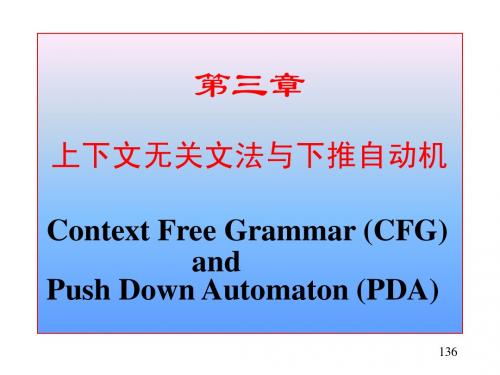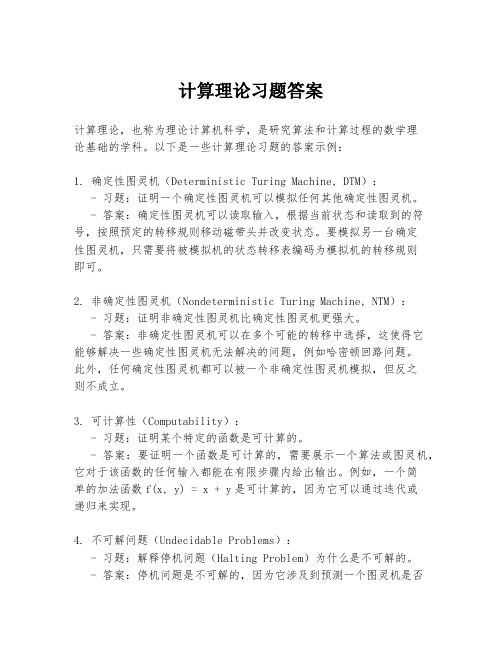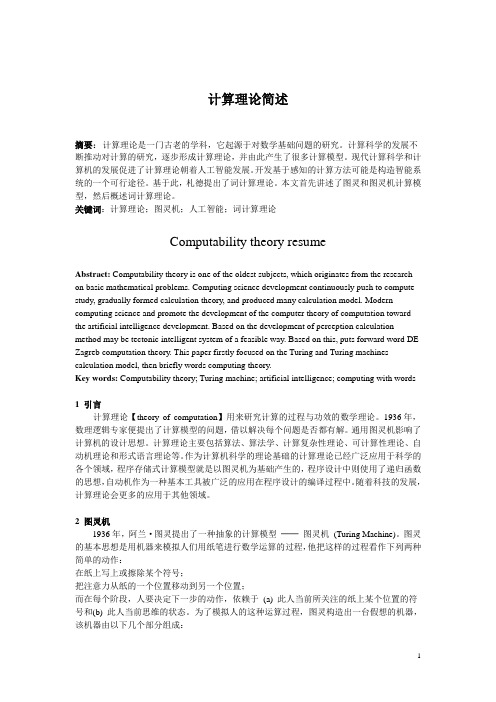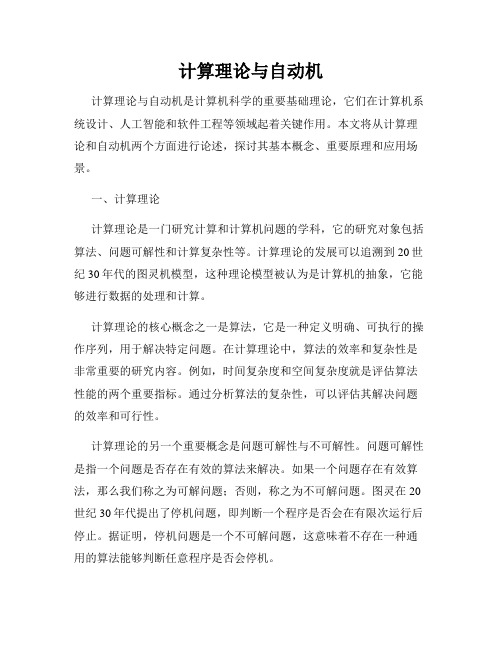计算理论20110421y
计算理论第3章

下面证明此算法的有效性。 显然对任何变元A∈NEWVN,不论A是在第⑵步还是在第 ⑸步加入到NEWVN中的,都有派生A*w,其中w∈VT*。 只证明G中任何派生A*w,w∈VT*,必有A∈NEWVN。 (对派生的步数归纳证明) a)若此派生是一步完成的,即有Aw,则说明P中有产 生式Aw,于是A在算法的第⑵步被添加到NEWVN中。 b)假设G中派生A*w是少于k步完成的,则A∈NEWVN。 c)当G中有k步派生AX1X2 …Xnk-1w,不妨设 w=w1w2 …wn,其中Xi*wi,(i=1,2,…,n),而且由于这些 派生的步数少于k步,如果Xi是变元,则根据假设b)得Xi 最终会加入到NEWVN中。在执行算法的第⑷步时 OLDVN:=NEWVN,当最后一个Xi加入OLDVN时,在执 行算法的第⑸步时,就将A加入到NEWVN中。
149
2.构造P’:是由P中只含有(VN’∪VT’)中的符号的 产生 式构成的。 3.证明L(G)=L(G’) a)显然有L(G’)L(G),因为VN’VN,VT’VT, P’ P,所以G’中任何派生S*w,在G中也有S*w。所以 L(G’)L(G)。 b)证明L(G)L(G’),任取w∈L(G),不妨设w在G中的 派生为S*αXβ*w,其中α,β∈(VN∪VT)*,由上 述算法可知,在此派生中出现的所有符号,都不会因为 对G使用此引理而被去掉,所以这些符号必在VN’∪V T’ 中,此派生中所用到的产生式也在P’中,所以这个派生 在G’中也可以实现,因而必有w∈L(G’)。 故 150 L(G)L(G’)。
解:先对G应用引理3-2.1方法处理,执行此算法得到的 结果如表3-2.2所示。 循环次数i OLDVN NEWVN 初值 Φ {S,A} 1 {S,A} {S,A }
152
计算理论习题答案

计算理论习题答案计算理论,也称为理论计算机科学,是研究算法和计算过程的数学理论基础的学科。
以下是一些计算理论习题的答案示例:1. 确定性图灵机(Deterministic Turing Machine, DTM):- 习题:证明一个确定性图灵机可以模拟任何其他确定性图灵机。
- 答案:确定性图灵机可以读取输入,根据当前状态和读取到的符号,按照预定的转移规则移动磁带头并改变状态。
要模拟另一台确定性图灵机,只需要将被模拟机的状态转移表编码为模拟机的转移规则即可。
2. 非确定性图灵机(Nondeterministic Turing Machine, NTM):- 习题:证明非确定性图灵机比确定性图灵机更强大。
- 答案:非确定性图灵机可以在多个可能的转移中选择,这使得它能够解决一些确定性图灵机无法解决的问题,例如哈密顿回路问题。
此外,任何确定性图灵机都可以被一个非确定性图灵机模拟,但反之则不成立。
3. 可计算性(Computability):- 习题:证明某个特定的函数是可计算的。
- 答案:要证明一个函数是可计算的,需要展示一个算法或图灵机,它对于该函数的任何输入都能在有限步骤内给出输出。
例如,一个简单的加法函数f(x, y) = x + y是可计算的,因为它可以通过迭代或递归来实现。
4. 不可解问题(Undecidable Problems):- 习题:解释停机问题(Halting Problem)为什么是不可解的。
- 答案:停机问题是不可解的,因为它涉及到预测一个图灵机是否会在有限步骤内停止。
如果存在一个算法能够解决停机问题,那么我们可以构造一个悖论,即一个图灵机可以模拟自身并决定自己是否会停止,这会导致自指的悖论。
5. 复杂性类(Complexity Classes):- 习题:区分P类问题和NP类问题。
- 答案:P类问题是指可以在多项式时间内解决的问题,而NP类问题是指可以在多项式时间内验证一个解的问题。
2计算理论与计算模型

2计算理论与计算模型计算理论和计算模型是计算机科学中非常重要的概念,它们对计算机科学的发展和应用产生了深远的影响。
计算理论是研究计算问题的基础理论,包括了算法、复杂性理论、计算复杂度理论等内容;而计算模型是描述计算机的抽象模型,包括了有限自动机、图灵机、lambda演算等多种模型。
在这篇文章中,我们将探讨计算理论和计算模型之间的关系,以及它们在计算机科学领域中的应用。
首先,让我们来看看计算理论和计算模型之间的关系。
计算理论是研究计算问题的数学理论,主要包括了算法的设计和分析、计算复杂性的研究等内容。
算法是一种解决问题的步骤序列,其设计和分析是计算理论的核心内容之一、通过研究算法,我们可以了解到如何高效地解决各种不同的计算问题,从而提高计算机科学的效率和实用性。
另一方面,计算模型是描述计算机的抽象模型,用来帮助我们理解计算机是如何进行计算的。
常见的计算模型包括了有限自动机、图灵机、lambda演算等。
有限自动机是一种具有有限个状态和转移规则的抽象计算模型,用来描述自动控制系统的行为。
而图灵机是英国数学家图灵提出的一种理论计算模型,它可以模拟任何计算问题的解决过程。
lambda演算则是由数学家艾伦·图灵和斯蒂芬·科尔尼(Stephen Cole Kleene)提出的一种基于λ演算符号的计算模型,用来描述函数式编程语言的计算过程。
计算理论和计算模型之间有着密切的关系。
计算理论提供了研究计算问题的基础理论,而计算模型则帮助我们理解计算机是如何进行计算的。
通过研究计算理论和计算模型,我们可以更好地理解计算机科学中的各种重要概念和理论,为计算机科学的发展和应用奠定了坚实的基础。
在计算机科学领域中,计算理论和计算模型有着广泛的应用。
在算法设计和分析方面,计算理论提供了许多重要的方法和技术,如分治法、动态规划、贪心算法等,用来解决各种不同的计算问题。
在计算复杂性理论方面,计算理论帮助我们理解计算问题的困难程度,并提出了许多重要的结论,如P=NP问题、NP完全问题等。
计算理论第一章绪论

1.1 计算与计算模型
上世纪初,德国大数学家希尔伯特(Hilbert)提出: 是否存在着一个通用过程,这个过程能用来判
定任意数学命题是否成立,即,输入一个数学命题, 在有限时间内,得到一个证明,如果这个命题成立; 或是一个反例,如果这个命题不成立。
图灵证明了对于平面几何来说,存在这样的过程。 但是,对于一般的数学命题,不存在这样的过程。
图灵机和可计算函数
英国 数学家
1936年,图灵24岁时发表一篇 论文《论数字计算在判决难题 中的应用》,提出著名的“图 灵机”的设想。这一思想奠定 了现代计算机的基础。
美国计算机协会在图灵去世12 年后以他的名字命名了计算机 领域的最高奖“图灵奖”。
艾伦·图灵(1912-1954)
1.1 计算与计算模型
判定。
1.3图灵机
NP完全问题:
NP类中某些问题的复杂性与整个类的复杂 性相关联,这些问题称为NP完全问题。
可计算性与计算复杂性
可计算性computability 是否可解
复杂性 complexity 解的难易程度
1.4 语言与文法
乔姆斯基最初从产生语言的角度研究语言, L*。
问题:考察一个字符串是否是某个语言的句 子。
计算的图灵机定义:
1936年由Turing给出,定义计算为: 输入—执行过程(有限步内结束)—输出
1946年,冯·诺依曼与宾夕法尼亚大学的工程师 采用电子器件物理实现了图灵的计算模型,建成 了世界的第一台计算机。
现在称计算机的体系结构为冯·诺依曼体系结构。
1.1 计算与计算模型
图灵给出了过程的科学定义,区分了可计算 的问题和不可计算的问题。
1.6 计算逻辑与描述逻辑
计算理论课件第三章

式时间内可以验证其解的正 问题规模的增大而急剧增加,
确性,但至今尚未找到多项 导致在实际应用中往பைடு நூலகம்难以
式时间算法来求解的问题。
求解。
所有NP完全问题在多项式时间 内可以相互转化,即如果一个 问题能够在多项式时间内求解 ,那么其他所有NP完全问题也 能够在多项式时间内求解。
NP完全问题涵盖了计算机科 学、数学、物理学等多个领
03
探讨利用光的物理特性进行计算的新方法,包括光计算基本原
理、光量子计算技术、光计算应用等。
近似算法与启发式算法研究动态
近似算法设计与分析
研究在多项式时间内求解NP难问题的近似算法,分析其时间复杂度和近似比等性能指标 。
启发式算法原理及应用
探讨模拟自然界现象或过程的启发式算法,如遗传算法、蚁群算法、粒子群算法等,以及 它们在组合优化、机器学习等领域的应用。
丘奇-图灵论题
1 2
丘奇-图灵论题的定义
所有可有效计算的函数都可以用图灵机来计算。
丘奇-图灵论题的意义
奠定了计算机科学的基础,为计算机程序设计提 供了理论支持。
3
丘奇-图灵论题的应用
用于证明某些问题的不可解性,如停机问题等。
不可计算性证明
01
不可计算性的定义
指某些问题无法用图灵机在有限步骤内得出答案。
可满足性问题(SAT Problem):给定一个布尔表 达式,求解是否存在一种变量赋值使得表达式为真。
NP完全问题在实际应用中的意义
算法设计挑战
NP完全问题的存在为 算法设计领域提供了持 续的挑战和动力,推动 了计算机科学领域的发 展。
评估问题难度
NP完全问题作为一类 难解问题的代表,为评 估其他问题的难度提供 了一个基准。如果一个 新问题被证明是NP完 全的,那么我们可以认 为这个问题是难解的。
计算理论课后习题答案50页PPT

46、我们若已接受最坏的,就再没有什么损失。——卡耐基 47、书到用时方恨少、事非经过不知难。——陆游 48、书籍把我们引入最美好的社会,使我们认识各个时代的伟大智者。——史美尔斯 49、熟读唐诗三百首,不会作诗也会吟。——孙洙 50、谁和我一样用功,谁就会和我一样成功。——莫扎特
计算理论课后习题答案
1、合法而稳定的权力在使用得当时很 少遇到 抵抗。 ——塞 ·约翰 逊 2、权力会使人渐渐失去温厚善良的美 德。— —伯克
3、最大限度地行使权力总是令人反感 ;权力 不易确 定之处 始终存 在着危 险。— —塞·约翰逊 4、权力会奴化一切。——塔西佗
5、虽然权力是一头固执的熊,可是金 子可以 拉着它 的鼻子 走。— —莎士 比
计算理论基础知识

计算理论基础知识计算理论是计算机科学的核心领域之一,它研究的是计算过程的本质和限制。
在计算机科学的发展过程中,计算理论提供了重要的理论基础和方法,为计算机科学和技术的发展奠定了坚实的基础。
本文将简要介绍计算理论的基础知识。
一、自动机理论自动机是计算理论中的重要概念之一,它用于描述计算过程的抽象模型。
自动机可以分为有限自动机和非确定性有限自动机等多种类型。
有限自动机是一种最简单的计算模型,它由状态、输入字母表、转换函数和初始状态等组成。
通过状态的转换和输入的驱动,有限自动机可以执行特定的计算任务。
非确定性有限自动机则相对更加复杂,它在进行状态转换时可以有多个可能的选项。
二、形式语言与文法形式语言和文法是计算理论中研究自动机行为规律的重要工具。
形式语言是由符号组成的集合,用于表示计算过程中的输入、输出和中间结果等信息。
文法则定义了形式语言的句子生成规则。
常见的文法类型有上下文无关文法、上下文相关文法等。
形式语言和文法的研究使得我们能够通过规则来描述和分析计算过程,从而更好地理解计算机科学中的一些重要概念和问题。
三、图灵机和可计算性理论图灵机是计算理论中最重要的概念之一,它由一个无限长的纸带和一个读写头组成。
图灵机通过读写头在纸带上的移动和改写来模拟计算过程。
图灵机的提出使得我们能够更深入地研究计算过程的本质和限制。
可计算性理论是计算理论中的一个重要分支,它研究的是什么样的问题可以通过某种计算模型解决。
根据可计算性理论,存在一些问题是不可计算的,即无法用任何计算模型来解决。
四、复杂性理论复杂性理论是计算理论中的另一个重要分支,它研究的是计算问题的复杂度。
复杂性理论主要关注计算问题的难解性和可解性。
常见的复杂性类别有P类、NP类等。
P类问题是可以在多项式时间内解决的问题,而NP类问题是可以在多项式时间内验证解的问题。
复杂性理论的研究使得我们能够更好地理解计算问题的本质,从而设计更高效的算法和方法。
五、计算复杂性和可计算性的关系计算复杂性和可计算性是计算理论中两个重要的概念。
计算理论与算法

将问题分解为若干个子 问题,通过求解子问题 的最优解来得到原问题 的最优解的思想,适用 于具有重叠子问题和最 优子结构性质的问题。
03
复杂度理论
时间复杂度与空间复杂度
1 2
时间复杂度
评估算法执行时间随输入规模增长的速度,常用 大O表示法(如O(n), O(n^2), O(log n)等)来 描述。
广度优先搜索(BFS)
从某个顶点出发,逐层访问图中所有顶点,直到达到指定顶点或无 法再访问为止。
图的遍历应用
用于解决图的连通性问题、寻找图中的路径、生成拓扑排序等问题。
最小生成树与最短路径算法
01
最小生成树(MST)
对于连通的无向图,一个包含图中所有顶点的连通子图,且所有边的权
值之和最小。常用算法有Prim算法和Kruskal算法。
时间复杂度
动态规划和分治策略的时间复杂度通常取决于问题的规模 和子问题的数量。在某些情况下,动态规划可能比分治策 略更高效,因为它避免了重复计算子问题。
06
计算几何与算法
计算几何基本概念与性质
点、线、面的表示与性质
计算几何中的基本元素包括点、线、面等,它们在计算机中的表 示方式及其性质是研究计算几何的基础。
01
几何搜索
02
最近点对问题
03
应用场景
几何搜索是指在几何数据集中查找满 足特定条件的几何对象,如查找最近 的点、线、面等。常见的几何搜索算 法有KD树、四叉树、R树等。
最近点对问题是指在给定的点集中找 到距离最近的两个点。该问题可以通 过分治算法在O(nlogn)的时间复杂度 内解决。
几何搜索和最近点对问题在计算机图 形学、计算机视觉、机器人学等领域 有着广泛的应用,如三维模型检索、 图像特征匹配、机器人避障等。
计算理论第2章去某范式版

⑷ ({A,B},{0,1},{A0,A1,A0A,A1A },A)。
⑸ ( { S,A,B,C,D}, {a,b,c,d,#},{SABCD, Sabc#,AaaA,ABaabbB,BCbbccC, cCcccC,CDccd#,CDd#,CD#d},S)。
Copyright 广东工业大学计算机学院 曾安, 2007. All rights reserved.
文法的构造例2
L={0n|n≥1}
G6:S0|0S
L={0n|n≥0}
G7:Sε |0S
L={02n13n|n≥0}
G8:Sε |00S111
Copyright 广东工业大学计算机学院 曾安, 2007. All rights reserved.
上下文无关文法的引入
有穷自动机和正则表达式这两种不同但等 价的描述语言的方法,虽然能描述许多语 言,但还有一些简单的语言不能用它们描 述,如:{0n1n | n>=0}
于是,需引入一种能力更强的描述语言数 学模型-上下文无关文法,它能够描述某 些应用广泛的具有递归结构特征的语言
Copyright 广东工业大学计算机学院 曾安, 2007. All rights reserved.
Copyright 广东工业大学计算机学院 曾安, 2007. All rights reserved.
文法的构造例1
例:构造文法G,使L(G)={0,1,00,11} G1: S0|1|00|11
G2:SA|B|AA|BB,A0,B1 G3:S0|1|0A|1B,A0,B1 G4:SA|B|AA|BB,A0,B1 G5:CS11A,|BC|BB,2 A0,B1,CACS21,
Copyright 广东工业大学计算机学院 曾安, 2007. All rights reserved.
《计算理论》

《计算理论》计算理论计算理论是计算机科学的一个重要分支,它研究计算的本质、计算机的局限性、算法的复杂性等问题。
计算理论不仅对计算机科学的理论研究有着重要的贡献,而且对计算机科学的实际应用也有着重要的指导意义。
本文将从计算理论的基础概念、重要方法和应用研究方面分别进行综述。
一、计算理论的基础概念计算理论的基础概念包括自动机、图灵机、可计算性、复杂性等。
1.自动机自动机是一种数学模型,描述一组有限状态与转换规则,它可以接受或拒绝输入的序列。
其种类包括有限自动机、下推自动机、图灵机等,其中图灵机是计算理论中最重要的一种自动机。
2.图灵机图灵机是由英国数学家图灵(Alan Turing)在1936年提出的,它是一种虚拟机器,可以模拟任何其他计算模型的算法,其所能解决的问题可以称之为可计算问题。
图灵机包括状态寄存器、可写磁带、读写头等组成部分,它可以读取磁带上的输入符号,根据规则执行计算,并将结果输出到磁带上。
3.可计算性可计算性是计算理论中的一个基本概念,它指的是能够通过某种计算模型进行计算的问题。
如果一个问题可以被图灵机计算,那么它就具有可计算性。
4.复杂性复杂性是计算理论中的另一个核心概念,它指的是计算的时间和空间复杂度。
时间复杂度指的是算法执行所需的时间,而空间复杂度指的是算法执行所需的空间。
通常通过渐进符号来表示算法的复杂性,如O(n)、O(nlogn)等。
二、计算理论的重要方法计算理论的重要方法包括可计算性理论、复杂性理论、自动机理论等。
1.可计算性理论可计算性理论是研究问题的可计算性的理论。
该理论主要使用图灵机等计算模型来描述问题的可计算性,其重要结论包括:(1)停机问题不可解停机问题是指给定一个程序及其输入,是否可以在有限时间内停止运行。
停机问题不可解意味着不存在一个通用算法,可以判定任意程序是否会在有限时间内停机。
(2)哥德尔不完备定理哥德尔不完备定理指的是,任何形式化的公理化系统都存在某些命题是无法通过该系统来证明的。
计算理论课后习题答案

b
Φ
c
{f}
d
{f}
e
{f
f
}Φ
1 {d,b} {d,b} {f,d,b} {d,b} {f,d,b}
Φ
5.化简正规表达式 a(ε+aa)*(ε+a)b+b+φ(ab*+b)*。 解:上式=a(aa)*(ε+a)b+b 其中(aa)*(ε+a)代表集合: {ε,aa,aaaa,aaaaaa,…}{ε,a} = {ε,aa,aaaa,aaaaaa,…}{a,aaa,aaaaa,…} ={ε,a,aa,aaa,aaaa,aaaaa,aaaaaa,…}={a}* 于是上式=aa*b+b=a+ b+b= (a++ε)b= a*b
K’={[p],[p,q],[p,r],[p,s],[p,q,r],[p,q,s],[p,r,s],[p,q,r,s]} F’ ={ [p,s],[p,q,s],[p,r,s],[p,q,r,s]}
4.将下面的ε-NFA M等价变换成NFA M’。
ε
ε a0
b c
1 ε
d ε
e
0 1
f
解:M’=(K, ∑, δ’,q0 ,F’),q0是M的开始状态,其中
解:令 M2=(K’,∑, δ’, q0’,F’), 其中 K’2K,K’中的元素是由K的子集
δ0 1 p {p,q} {p} q {r } {r}
{q1,q2,…,qi}构成,但是要把子集
r {s} Φ
{q1,q2,…,qi}作为的一个状态看待,
s {s} {s}
因此把此子集写成[q1,q2,…,qi]。
F
F {
计算理论简述

计算理论简述摘要:计算理论是一门古老的学科,它起源于对数学基础问题的研究。
计算科学的发展不断推动对计算的研究,逐步形成计算理论,并由此产生了很多计算模型。
现代计算科学和计算机的发展促进了计算理论朝着人工智能发展。
开发基于感知的计算方法可能是构造智能系统的一个可行途径。
基于此,札德提出了词计算理论。
本文首先讲述了图灵和图灵机计算模型,然后概述词计算理论。
关键词:计算理论;图灵机;人工智能;词计算理论Computability theory resumeAbstract: Computability theory is one of the oldest subjects, which originates from the research on basic mathematical problems. Computing science development continuously push to compute study, gradually formed calculation theory, and produced many calculation model. Modern computing science and promote the development of the computer theory of computation toward the artificial intelligence development. Based on the development of perception calculation method may be tectonic intelligent system of a feasible way. Based on this, puts forward word DE Zagreb computation theory. This paper firstly focused on the Turing and Turing machines calculation model, then briefly words computing theory.Key words: Computability theory; Turing machine; artificial intelligence; computing with words1 引言计算理论【theory of computation】用来研究计算的过程与功效的数学理论。
大基6-3:计算理论

6.3.3 计算复杂性理论
• 计算复杂性: 用计算机求解问题的难易程度 • 度量标准 :
• 1、计算所需的步数或指令条数即时间复杂度 • 2、计算所需的存储单元数量即空间复杂度
6.3.2 可计算性理论
3.判定性问题 • 判定问题是无穷多个同类个别问题的总称。
• 例如,2是不是素数?6是不是素数?这些都是个别问题 • 把这类个别问题概括起来,就得到一个判定问题:任意给定的
正整数是不是素数? • 这里的正整数集合称为该判定问题的域,给定域中的一个元素,
判定问题就对应一个个别问题。
6.3 计算理论
• 问题求解的计算过程
6.3.1计算模型及计算能力
• 从20世纪30年代开始,为了讨论所有问题是否都有求解的算法, 数学家和逻辑学家从不同角度提出了几种不同的算法概念精确 化定义。
1935
邱奇提出 λ转换演算
1936
哥德尔等定 义递归函数
1936 1943
图灵和波斯特各 自提出抽象计算 机模型
• 停机问题的关键:能否找到一个测试程序,这个测试程序能判 定任何一个程序在给定的输入下能否终止。
• 数学反证法证明:先假设存在这样的测试程序,然后再构造一 个程序,该测试程序不能测试
• 假设存在一个测试程序T,它能接受任何输入。
• 当输入程序P能终止,输出1;
•
P不能终止,输出0。
6.3.2 可计算性理论
• 可计算性的特征包括: • 确定性:由相同的初始条件,得到相同的结果。 • 有限性:能在有限时间内,在有限设备上执行。 • 机械性:每一个计算过程的执行都是“机械的”或“构造的”, 且可以被精确地描述 • 可执行性:计算过程的语句甚至是有限的,且自身能被表示为 自然数 • 终止性:接收初始输入后能否达到停机状态。
计算理论与自动机

计算理论与自动机计算理论与自动机是计算机科学的重要基础理论,它们在计算机系统设计、人工智能和软件工程等领域起着关键作用。
本文将从计算理论和自动机两个方面进行论述,探讨其基本概念、重要原理和应用场景。
一、计算理论计算理论是一门研究计算和计算机问题的学科,它的研究对象包括算法、问题可解性和计算复杂性等。
计算理论的发展可以追溯到20世纪30年代的图灵机模型,这种理论模型被认为是计算机的抽象,它能够进行数据的处理和计算。
计算理论的核心概念之一是算法,它是一种定义明确、可执行的操作序列,用于解决特定问题。
在计算理论中,算法的效率和复杂性是非常重要的研究内容。
例如,时间复杂度和空间复杂度就是评估算法性能的两个重要指标。
通过分析算法的复杂性,可以评估其解决问题的效率和可行性。
计算理论的另一个重要概念是问题可解性与不可解性。
问题可解性是指一个问题是否存在有效的算法来解决。
如果一个问题存在有效算法,那么我们称之为可解问题;否则,称之为不可解问题。
图灵在20世纪30年代提出了停机问题,即判断一个程序是否会在有限次运行后停止。
据证明,停机问题是一个不可解问题,这意味着不存在一种通用的算法能够判断任意程序是否会停机。
计算理论的研究成果不仅为计算机科学提供了坚实的理论基础,而且也为计算机系统的设计和开发提供了指导原则。
例如,计算理论中的自动机理论和形式语言理论对编译器、解释器和操作系统等软件开发工作起着重要的启示作用。
二、自动机自动机是计算理论的一个重要分支领域,它研究的是一种抽象的计算模型。
自动机理论可以描述和分析计算系统在给定输入下的行为以及它们的计算能力。
自动机可以分为有限自动机和无限自动机两类。
有限自动机是一种状态机模型,它由有限多个状态、输入字母表和状态转移函数组成。
有限自动机能够接受输入字符串并根据预定义的规则进行状态转移,最终停留在某个状态。
有限自动机常用于模式匹配、词法分析和编译器设计等领域。
无限自动机是一种能够处理无限输入序列的计算模型。
计算理论导引第二版课程设计

计算理论导引第二版课程设计课程背景计算理论是计算机科学的重要基础,它涵盖了计算机科学与数学两个领域。
作为计算机科学专业的学生,掌握计算理论知识对于深入理解计算机科学的本质和机理具有不可替代的作用。
为进一步推进计算理论的教学质量,配合《计算理论导引》第二版课程教材的使用,本课程设计旨在帮助学生更好地掌握计算理论相关知识和理论,并培养其相关的编程能力、分析能力和创新能力。
课程目标通过本课程设计的实践教学,学生应具备以下知识和能力:1.掌握计算理论的基本概念、基础知识和主要方法。
2.掌握有关自动机理论、语言理论、计算复杂性理论、理论计算机科学等方面的知识。
3.具有利用计算理论解决实际问题以及分析和设计相关算法的能力。
4.具有一定的论文撰写和技术报告写作能力,为将来的科研或实践工作打下良好基础。
课程内容课程设计内容一共分为三个部分:实验报告撰写、编程实践与算法设计与分析。
具体如下:实验报告撰写学生需要举行两次实验,第一次实验选项如下:1.模拟一个应用自动机的解析器,解析一个简单的编程语言,比如C语言的if、while、for等结构,并能输出对应的语法树。
2.模拟一个NFA转化为DFA的算法,并通过比较两者的状态转移图,分析其对应语义。
3.模拟一个PDA,让它接受一些简单的字符串,并输出接受过程中的状态变迁。
第二次实验选项如下:1.设计一个简单的语言文法,实现对该语言的词法分析和语法分析。
2.实现一个线性时间的算法,将正则表达式转化为自动机。
3.模拟一个图灵机,实现其对于一个给定问题的求解过程。
实验报告的撰写应包括实验介绍、方法、结果及分析等部分,同时也应该注重技术报告写作的相关要求。
编程实践为加深学生对计算理论的理解,课程设计还包括编程实践环节,主要内容如下:1.编写一个NFA模拟器,能够对输入的字符串根据自动机的状态转移规则进行检验,输出该字符串能否被该NFA接受。
2.编写一个算法,实现正则表达式的匹配功能。
计算理论概述.ppt

B
后续离穴觅食者选择外激素浓度大的AC路径, 于是AC上外激素浓度将越来越大, 最后,绝大多数蚂蚁沿较短的AC路径觅食。
A 蚁穴
C
食物
蚁群算法
初始化,设置时间计数器,循环计数器,为每条 边设置信息素浓度的初始值
初始化tabu表
tabu表满?
按概率将某一个蚂蚁从第i个城市移动到第 j个城市,并将j插入其tabu表
问题的求解是计算,求解算法中的每个步骤是计算 计算的过程是算法,算法又由计算步骤构成 计算的目的由算法实现,算法的执行由计算完成
什么是计算
--从工匠到设计师 • 计算机械化与现代化
计算技术发展:个人的才智与技能-大众技能-计算工具 -自动化-现代化 早期工具:算筹-算盘-计算尺-手摇计算机(早期发报机) 现代工具:电子计算机(器)-超级计算机-网络 无处不在的计算:计算网格与云计算-物联网与普适计算
Step2:
评价每个粒子的适应度;
Step3:
对每个粒子,将其适应值与其经历过的最好位置pbest作比较, 如果较好,则将其作为当前的最好位置pbest;
Step4:
对每个粒子,将其适应值与全局所经历的最好位置gbest作比 较,如果较好,则重新设置gbest的索引号;
Step5:
根据方程(1)变化粒子的速度和位置;
• 自下而上的研究思路
传统人工智能研究思路是自上而下,现代智能计算方法强调 通过计算实现生物内在的智能行为,也称为计算智能
• 从简单到复杂的演化进程
智能的获得不是一蹴而就,是渐进式的积累过程,简单中孕 育复杂,平凡中蕴含智慧
• 在传统学科中寻找算法
如生命科学(遗传算法)、物理学(模拟退火算法)和化学 (DNA计算)等
- 1、下载文档前请自行甄别文档内容的完整性,平台不提供额外的编辑、内容补充、找答案等附加服务。
- 2、"仅部分预览"的文档,不可在线预览部分如存在完整性等问题,可反馈申请退款(可完整预览的文档不适用该条件!)。
- 3、如文档侵犯您的权益,请联系客服反馈,我们会尽快为您处理(人工客服工作时间:9:00-18:30)。
Introduction to the Theory of Computation and Algorithm Complexities
主讲: 主讲:刘国华 (学院楼①225室,ghliu@) 学院楼①225室 ) 助教: 助教:辛婷婷 学院楼①153室 (学院楼①153室,xtt.moon@) ) FTP:222.204.215.3
CHAPTER 3 ALGORITHEMS(2)
• THE HAITING PROBLEM(ACCEPTANCE PROBLEM) 1 THE DIAGONALIZATION METHOD 1)Correspondence:a function that is both one-to-one and onto. 2)Countable set: a set A is countable if either it is finite or it has the same size as N. THEOREM 3.8 R is incountable. PROOF IDEA. To show that no correspondence exists between N and R. METHOD:contradiction To construct a real number x whose ith fractional digit is different from f(i)’s,1≤i≤n.
On input <D>: 1. Run H on input <D, <D>>. 2. D rejects <D>, if D accepts <D>; D accepts <D>,if D rejects <D>.”
CHAPTER 3 ALGORITHEMS(2)
The universe of languages Turing-recognizable languages
CHAPTER 3 ALGORITHEMS(2)
COROLARY 3.2 ATM is not Turing-recognizable. • REDUCIBILITY A way of converting one problem to another problem in such a way that a solution to the second problem can be used to solve the first problem. If problem A can reduce to problem B. We can know: 1.Solving problem A can not be harder than problem B. 2.If B is decidable, then A also is decidable. 3.If A is undecidable, then B also is undecidable.
CHAPTER 3 ALGORITHEMS(2)
• THE HAITING PROBLEM(ACCEPTANCE PROBLEM) ATM={<M,w>|M is a TM and M accepts w} U=“On input<M,w>,where M is a TM and w is a string: 1.Simulate M on input w. 2.If M ever enters its accept state, accept; if M ever enter its reject state, reject.” If M loops, what will we do?
The complement of Turing-recognizable languages
CHAPTER 3 ALGORITHEMS(2)
3 A TURING-UNRECOGNIZABLE LANGUAGE Co-Turing-recognizable language: a language is co-Turingrecognizable if it is the complement of a Turingrecognizable language and Turing-recognizable. THEOREM 3.10 A language is decidable iff it is Turing-recognizable and coTuring-recognizable. PROOF IDEA M=“On input w: 1.Run both M1 and M2 on input w in parallel. 2.If M1 accepts, accept; if M2 accept, reject.”
CHAPTER 3 ALGORITHEMS(2)
•UNDECIDABLE PROBLEMS FROM LANGUEAGE THEORY 1. HALTTM={<M, w>|M is a TM and M halts on input w}. THEOREM 3.11 HALTTM is undecidable. PROOF IDEA METHOD: contradiction Problem A is ATM, problem B is HALTTM, if A reduces to B, then we can know: If B is decidable, then A also is decidable. To assume that we have a TM R that decides HALTTM S=“On input <M, w>, an encoding of a TM M and a string w: 1.Run TM R on input<M, w>. 2.If R rejects, reject. 3.If R accepts, simulate M on w until it halts. 4.If M has accepted, accept; if M has rejected, reject.”
CHAPTER 3 ALGORITHEMS(2)
• MAPPING REDUCIBILITY
* putable function: A function f:Σ→Σ*is a computable Σ→Σ function if some Turing machine M, on every input w, halts with just f(w) on its tape. 2.Mapping reducible language: Language A is mapping reducible to language B, written A≤m B ,if there is a ≤ * computable function f: Σ→Σ* , where for every w, w∈A⇔f(w)∈B. ∈ ⇔ ∈ The function f is called the reduction of A to B. THEOREM 3.14 If A≤ mB and B is decidable, then A is decidable. ≤
CHAPTER 3 ALGORITHEMS(2)
n 1 2 3 4 f(n) 3.14159… 55.55555… 0.12345… 0.50000…
…
…
x=0. 2111 …
CHAPTER 3 ALGORITHEMS(2)
COROLLARY 3.1 Some language are not Turing-recognizaTuring machine is countable; 2)The set of all language is uncountable; (1)The set of all infinite binary sequences is uncountable; (2) The set of all language and the set of all infinite binary sequences are the same size.
CHAPTER 3 ALGORITHEMS(2)
3. REGULARTM={<M>|M is a TM and L(M) is a regular language}. THEOREM 3.13 EREGULARTM is undecidable. 4.EQTM={<M1,M2>|M1 and M2 are TMs and L(M1) =L(M2)}. THEOREM 3.13 EQTM is undecidable.
CHAPTER 3 ALGORITHEMS(2)
PROOF IDEA M for B. f is the reduction of A to B. N=“ On input w: pute f(w). 2.Run M on input f(w) and output whatever M ouputs.” COROLLARY 3.3 If A≤ mB and is A undecidable, then B is undecidable. ≤ THEOREM 3.15 If A≤ mB and B is Turing-recognizable, then A is Turing≤ recognizable. COROLLARY 3.4 If A≤ B and A is not Turing-recognizable, then B is not ≤ Turing-recognizable.
CHAPTER 3 ALGORITHEMS(2)
2 THE HAITING PROBLEM(ACCEPTANCE PROBLEM) ATM={<M, w>|M is a TM and M accepts w} THEORM 3.9 ATM is undecidable. PROOF IDEA accept if M accepts w H(<M, w>)= reject if M does not accept w D=“On input <M>, where M is a TM: 1. Run H on input <M, <M>>. 2.Output the opposite of what H output; that is, if H accepts, reject and if H rejects, accept.”
